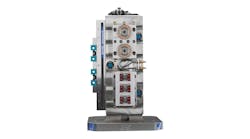Office drones (like me) wear earbuds so we can jam out to Pandora while we answer emails and write pithy copy, while muffling the chatter of loud co-workers (like me). You, on the other hand, or ear, wear industrial headphones to cancel out rumbling motors, screeching drills, and other cochlea-crushing equipment. And you wish you could hear what the guy a few feet away from you is saying.
Once you take off those headphones to hear your co-worker, you're instantly exposed to all those harmful, high-decibel noises. And you might just leave them off.
That's a common scenario that a pair of Irish physicists, Rhona Togher and Eimear O'Carroll discovered while researching ways to stop tinnitus, that occasional ringing in the ears that affects one in five people, according to the Mayo Clinic.
In 2009, they founded the Dublin-based company Restored Hearing to commercialize a 5-minute audio treatment app called Sound Relief that treats tinnitus. That wasn't enough, so working off the notion that half of all hearing loss is preventable, they went to the lab to find a permanent solution to hearing loss.
In the process, they developed a smart material 800% more absorbent than foam that can block out certain frequencies, while allowing lower sounds to enter, like an acoustic colander. This material has been inserted into headphones called Sound Bounce, and are expected to cost about $50. That's roughly the same as Sony noise-canceling headphones, but these are waterproof and don't need batteries to work, because they are powered by the sound you want to block out.
"The material, because of its physical nature, responds proportionately to amplitude, so the louder the sound, the more we absorb," O'Carroll explains. "That's why we can have a conversation and be understood and heard in the headset. When you're talking to someone, you're typically not too loud, so the material is relatively inactive at that stage. But you turn around and use a jackhammer, the material will instantaneously kick into gear."
Restored Hearing does this by gathering a frequency analysis of what you want to block and then using a secret process to adjust the thixotropic material to activate at 20 hz, for example. The material springs into actions and attenuates the noise. The housing is also specially to sensitize the material.
What exactly is thixotropic? It's a gel that becomes more fluid when disturbed, even by sound vibrations.
"So, basically, the material is approximately more solid at rest, if you apply energy, in this case sound energy, it becomes increasingly liquid and flows more and that process of changing its viscosity absorbs a lot of the sound energy," O'Carroll explains.
The most intriguing feature is that Restored Gearing can customize the material, allowing customers to select the frequency threshold.
"The material can be tuned to different types of noise," O'Carroll says. "We can make a version for a factory or a dentist drill, or a version for airfields around planes."
Testing is done by placing a headset on a test dummy in the lab, which has microphones on the interior of the earmuff to measure what the user would hear and another in the room to measure atmospheric noise. Then they compare that to the sound profile of the jackhammer, making sure the frequency and amplitude are blocked out. And the material is set to block that specific frequency.
Along with noisy industrial sites, shooting ranges seem like a perfect fit for these headphones, and O'Carroll has said several sports shooters have expressed interest. I asked if they can create a pair to filter out my infant daughter's cries, because I can hardly hear the TV over her shrieks for love and attention. O'Carroll said it was possible …
The material works great in headphones to block noise out for one person, but what if you wrap the thing making noise, be it a jackhammer or a baby, in Sound Bounce?
O'Carroll is actually working on this very theory, and believes it to be … sound.
"That's one way were looking at it,” O’Carroll says, “applying closer to the source."
Restored Hearing has talked to industrial partners in construction, automotive and aerospace to see how Sound Bounce can be applied in wall panels and on equipment.
The Kickstarter ends Jan. 27, and needs about $6,000 (as of Jan. 17). We believe this is a great campaign to support and bought a pair to give away in a future contest. If you can’t wait, pick up your own for the Early Bird price of $37. They ship in June 2017.
This article originally appeared on New Equipment Digest, a companion site of American Machinist and part of Penton's Manufacturing & Supply Chain group.






